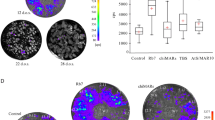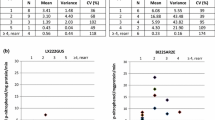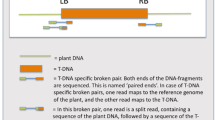Abstract
DNA repeats are associated with gene instability and silencing phenomena in plants. Therefore, the presence of a direct repeat of matrix-associated region (MAR) DNA, that considerably reduced position effects between independent transformants, may increase (epi)genetic instability. To investigate the influence of such a repeat on the stability of the expression of embedded transgenes, the meiotic stability of transgene expression was assessed in eighteen homozygous 1-locus transgenic tobacco lines carrying the kanamycin resistance (NPTII) and the β-glucuronidase (GUS) gene. Half of the lines carry a 3 kb direct repeat of MAR DNA flanking the transgenes. Large progeny populations, totalling over a million seedlings, were screened for kanamycin resistance with the help of a newly developed high-density seedling screen. Kanamycin-sensitive seedlings were detected in selfed progeny at a frequency of 0.5-5.9×10-4. The frequency became as high as 2×10-2 when embryo development occurred under heat and/or drought stress. In backcrossed progeny only, a joint loss of NPTII and GUS gene expression was observed at an average frequency of 2.9×10-5. In selfed and backcrossed progeny we observed similar frequencies of reversion to kanamycin sensitivity, indicating that epigenetic silencing mechanisms rather than MAR repeat-related homologous recombination underlie the reversal to kanamycin sensitivity. Different lines, hence different areas of the tobacco genome, differed in their genetic stability. No significant differences in reversal frequencies were apparent between lines with or without the MAR elements. The use of the MAR repeat is, therefore, not compromised by any increased (epi)genetic instability.
Similar content being viewed by others
References
Assaad FF, Signer ER: Somatic and germinal recombination of a direct repeat in Arabidopsis. Genetics 132: 553–566 (1992).
Bender J, Fink GR: Epigenetic control of an endogenous gene family is revealed by a novel blue fluorescent mutant of Arabidopsis. Cell 83: 725–734 (1995).
Brusslan JA, Karlin-Neumann GA, Huang L, Tobin EM: An Arabidopsis mutant with a reduced level of cab140 RNA is a result of cosuppression. Plant Cell 5: 667–677 (1993).
Cherdshewasart W, Gharti-Chhetri GB, Saul MW, Jacobs M, Negrutiu I: Expression instability and genetic disorders in transgenic Nicotiana plumbaginifolia Viv. plants. Trans Res 2: 307–320 (1993).
Chyi Y-S, Jorgensen RA, Goldstein D, Tanksley SD, Loaiza-Figueroa F:Locations and stability ofAgrobacterium-mediated T-DNAinsertions in the Lycopersicon genome. Mol Gen Genet 204: 64–69 (1986).
Conner AJ, Christey MC: Plant breeding and seed marketing options for the introduction of transgenic insect-resistant crops. Biocontrol Sci Tech 4: 463–473 (1994).
Czernilofsky AP, Hain R, Baker B, Wirtz V: Studies on the structure and functional organisation of foreign DNA integrated into the genome of Nicotiana tabacum. DNA 5: 473–482 (1986).
Darwin C: The Variation of Animals and Plants under Domestication, vol II. John Murray, London (1868).
Dehio C, Schell J: Stable expression of a single-copy rolA gene in transgenic Arabidopsis thaliana plants allows an exhaustive mutagenic analysis of the transgene-associated phenotype. Mol Gen Genet 241: 359–366 (1993).
de Vries H: The Mutation Theory: Experiments and Observations on the Origin of Species in the Vegetable Kingdom. Open Court, Chicago (1901).
Dorer DR, Henikoff S: Expansions of transgene repeats cause heterochromatin formation and gene silencing in Drosophila. Cell 77: 993–1002 (1994).
Gal S, Pisan B, Hohn T, Grimsley N, Hohn B: Genomic homologous recombination in planta. EMBO J 10: 1571–1578 (1991).
Gharti-Chhetri GB, Cherdshewasart W, Dewulf J, Jacobs M, Negrutiu I: Polyethylene glycol-mediated direct gene transfer in Nicotiana spp. Physiol Plant 85: 345–351 (1992).
Hänisch ten Cate CH, Loonen AEHM, Ottaviani MP, Ennik L, van Eldik G, Stiekema WJ: Frequent spontaneous deletions of Ri T-DNA in Agrobacterium rhizogenes transformed potato roots and regenerated plants. Plant Mol Biol 14: 735–741 (1990).
Heberle-Bors E, Charvat B, Thompson D, Schernthaner JP, Barta A, Matzke AJM, Matzke MA: Genetic analysis of TDNA insertions into the tobacco genome. Plant Cell Rep 7: 571–574 (1988).
KNMI: Maandoverzicht van het weer in Nederland. MOW Bull 91 (No. 6–9): 1–10 (1994).
Jorgensen R: Cosuppression, flower color patterns, and metastable gene expression states. Science 268: 686–691 (1995).
Laemmli UK, Käs E, Poljak L, Adachi Y: Scaffold-associated regions: cis-acting determinants of chromatin structural loops and functional domains. Curr Opin Genet Devel 2: 275–285 (1992).
Lebel EG, Masson J, Bogucki A, Paszkowski J: Stress-induced intrachromosomal recombination in plant somatic cells. Proc Natl Acad Sci USA 90: 422–426 (1993).
Linn F, Heidmann I, Saedler H, Meyer P: Epigenetic changes in the expression of the maize A1 gene in Petunia hybrida: role of numbers of integrated gene copies and state of methylation. Mol Gen Genet 222: 329–336 (1990).
Matzke MA, Matzke AJM: How and why do plants inactivate homologous (trans)genes? Plant Physiol 107: 679–685 (1995).
McClintock B: The significance of responses of the genome to challenge. Science 226: 792–801 (1984).
Meyer P, Linn F, Heidmann I, Meyer zu Altenschildesche H, Niedenoff I, Saedler H: Endogenous and environmental factors influence 35S promoter methylation of a maize A1 gene construct in transgenic petunia and its colour phenotype. Mol Gen Genet 231: 345–352 (1992).
Mlynárová L, Loonen A, Heldens J, Jansen RC, Keizer P, Stiekema WJ, Nap JP: Reduced position effect in mature transgenic plants conferred by the chicken lysozyme matrixassociated region. Plant Cell 6: 417–426 (1994).
Mlynárová L, Jansen RC, Conner AJ, Stiekema WJ, Nap JP: The MAR-mediated reduction in position effect can be uncoupled from copy number-dependent expression in transgenic plants. Plant Cell 7: 599–609 (1995).
Mlynárová L, Keizer LCP, Stiekema WJ, Nap JP: Approaching the lower limit of transgene variability. Plant Cell 8: 1589–1599 (1996).
Müller AJ, Mendel RR, Schiemann J, Simoens C, Inzé D: High meiotic stability of a foreign gene introduced into tobacco by Agrobacterium-mediated transformation. Mol Gen Genet 207: 171–175 (1987).
Murashige T, Skoog F: A revised medium for rapid growth and bioassays with tobacco tissue cultures. Physiol Plant 15: 473–497 (1962).
Nap JP, Conner AJ, Mlynárová L, Stiekema WJ, Jansen RC: Dissection of a synthesized quantitative trait to characterize transgene interactions. Genetics 147: 315–320 (1997).
Payne RW, Lane PW, Digby PGN, Harding SA, Leech PK, Morgan GW, Todd AD, Thompson R, Tunnicliffe Wilson G, Welham SJ, White RP: Genstat 5 (Release 3) Reference Manual. Clarendon Press, Oxford (1993).
Peterhans A, Schlüpmann H, Basse C, Paszkowski J: Intrachromosomal recombination in plants. EMBO J 9: 3437–3445 (1990).
Potrykus I, Paszkowski J, Saul MW, Petruska J, Shillito RD: Molecular and general genetics of a hybrid foreign gene introduced into tobacco by direct gene transfer. Mol Gen Genet 199: 169–177 (1985).
Puchta H, Swoboda P, Gal S, Blot M, Hohn B: Somatic intrachromosomal homologous recombination events in populations of plant siblings. Plant Mol Biol 28: 281–292 (1995).
Renckens S, De Greve H, Van Montagu M, Hernalsteens J-P: Petunia plants escape from negative selection against a transgene by silencing the foreign DNA via methylation. Mol Gen Genet 233: 53–64 (1992).
Rohlf FJ, Sokal RR: Statistical Tables, 3rd ed. Freeman and Co, New York (1994).
Sabl JF, Henikoff S: Copy number and orientation determine the susceptibility of a gene to silencing by nearby heterochromatin in Drosophila. Genetics 142: 447–458 (1996).
Simmonds NW: Principles of Crop Improvement. Longman, London (1979).
Smith CJS, Watson CF, Bird CR, Ray J, Schuch W, Grierson D: Expression of a truncated tomato polygalacturonase gene inhibits expression of the endogenous gene in transgenic plants. Mol Gen Genet 224: 477–481 (1990).
Sokal RR, Rohlf FJ: Biometry, 3rd ed. Freeman and Co, New York (1995).
Swoboda P, Hohn B, Gal S: Somatic homologous recombination in planta: The recombination frequency is dependent on the allelic state of recombining sequences and may be influenced by genomic position effects. Mol Gen Genet 237: 33–40 (1993).
Swoboda P, Gal S, Hohn B, Puchta H: Intrachromosomal homologous recombination in whole plants. EMBO J 13: 484–489 (1994).
Tovar J, Lichtenstein C: Somatic and meiotic chromosomal recombination between inverted duplications in transgenic tobacco plants. Plant Cell 4: 319–322 (1992).
UPOV: The Revised General Introduction to the Guidelines for the Conduct of Tests for Distinctiveness, Homogeneity and Stability of New Varieties of Plants. UPOV, Geneva (1979).
Vaucheret H: Identification of a general silencer for 19S and 35S promoters in a transgenic tobacco plant: 90 bp of homology in the promoter sequence are sufficient for transinactivation. CR Acad Sci Paris 316: 1471–1483 (1993).
Walbot V, Cullis CA: Rapid genomic change in higher plants. Annu Rev Plant Physiol 36: 367–396 (1985).
Walter C, Broer I, Hillemann D, Pühler A: High frequency, heat treatment-induced inactivation of the phosphinothricin resistance gene in transgenic single cell suspension cultures of Medicago sativa. Mol Gen Genet 235: 189–197 (1992).
Wernsman EA, Matzinger DF: Tobacco. In: Fehr WR, Hadley H (eds) Hybridization of Crop Plants, pp. 657–668. American Society of Agronomy, Madison, WI (1980).
Author information
Authors and Affiliations
Corresponding author
Rights and permissions
About this article
Cite this article
Conner, A.J., Mlynárová, L., Stiekema, W.J. et al. Meiotic stability of transgene expression is unaffected by flanking matrix-associated regions. Molecular Breeding 4, 47–58 (1998). https://doi.org/10.1023/A:1009637513628
Issue Date:
DOI: https://doi.org/10.1023/A:1009637513628




